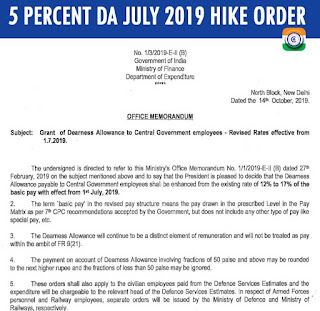Prevention of Sexual Harassment of Women at the Workplace – Amendments to CCS(Conduct)Rules 1964
G.I., Dep. of Per. & Trg., O.M.No. 11013/2/2014-Estt (A-III), dated 2.2.2015
Subject: Central Civil Services (Conduct) Rules 1964 — Guidelines regarding prevention of sexual harassment of women at the workplace— regarding
Following the promulgation of the Sexual Harassment of Women at Workplace (Prevention, Prohibition and Redressal) Act, 2013 [SHWW(PPR) Act] and notification of the Sexual Harassment of Women at Workplace (Prevention, Prohibition and Redressal) Rules, 2013 [SHWW(PPR) Rules] on 09.12.2013., the Government has recently, on 19.11.2014, notified the amendments to Central Civil Services (Conduct) Rules 1964 and Classification, Control and Appeal Rules, 1965. The amendments and other salient features of the Act/ Rules was brought to the notice of all concerned vide Office Memorandum of even no. dated 27.11.2014. The amendments to the Central Civil Services (Conduct) Rules 1964 and Classification, Control and Appeal Rules, 1965 and the Office Memorandum dated 01.12.2014 are available on the Department’s website.
2. The following guidelines, conveying the decision of the Committee of Secretaries on this subject, were issued vide this Department’s Office Memorandum No. 11013/3/2009-Estt.(A) dated 03.08.2009, “As regards provisions for protection of women, it was suggested that the complaints committee mechanism provided under Vishakha guidelines relating to sexual harassment should be strictly in accordance with the judgment and steps should be taken to ensure that the committee is effective and functional at all times. It would also be desirable for the Committees to meet once a quarter, even if there is no live case, and review preparedness to fulfil all requirements of the Vishakha judgment in the Department/Ministry/ organization concerned.”
3. As per the guidelines issued vide Office Memorandum dated 21.07.2009, it is also to be ensured that the Complaints Committee shall at all times be in existence and changes in its composition, whenever necessary, should be made promptly and adequately publicized. The composition of the Complaints Committee should also be posted on the websites of the concerned Ministries/Departments/Offices concerned.
4. Vide the Office Memorandum dated 01.12.2014, the attention of the Ministries/Departments was also invited to the reporting requirements mentioned in the SHWW(PPR) Act and SHWW(PPR) Rules.
5. All Ministries/ Departments are requested to please review the progress of implementation of the existing above mentioned guidelines issued in the aftermath of the Vishakha judgment.
6. Attention of all Ministries is invited to Section 22 of the Act relating to including information in Annual Report, and to request that information relating to number of cases filed, if any, and their disposal may be included in the Annual Report of the Ministry / Department.
7. All Ministries / Departments are also requested to furnish an annual return (as on 31 stMarch) in the enclosed proforma to this Department by 30th April every year.
Authority : www.persmin.gov.in (DoPT)
G.I., Dep. of Per. & Trg., O.M.No. 11013/2/2014-Estt (A-III), dated 2.2.2015
Subject: Central Civil Services (Conduct) Rules 1964 — Guidelines regarding prevention of sexual harassment of women at the workplace— regarding
Following the promulgation of the Sexual Harassment of Women at Workplace (Prevention, Prohibition and Redressal) Act, 2013 [SHWW(PPR) Act] and notification of the Sexual Harassment of Women at Workplace (Prevention, Prohibition and Redressal) Rules, 2013 [SHWW(PPR) Rules] on 09.12.2013., the Government has recently, on 19.11.2014, notified the amendments to Central Civil Services (Conduct) Rules 1964 and Classification, Control and Appeal Rules, 1965. The amendments and other salient features of the Act/ Rules was brought to the notice of all concerned vide Office Memorandum of even no. dated 27.11.2014. The amendments to the Central Civil Services (Conduct) Rules 1964 and Classification, Control and Appeal Rules, 1965 and the Office Memorandum dated 01.12.2014 are available on the Department’s website.
2. The following guidelines, conveying the decision of the Committee of Secretaries on this subject, were issued vide this Department’s Office Memorandum No. 11013/3/2009-Estt.(A) dated 03.08.2009, “As regards provisions for protection of women, it was suggested that the complaints committee mechanism provided under Vishakha guidelines relating to sexual harassment should be strictly in accordance with the judgment and steps should be taken to ensure that the committee is effective and functional at all times. It would also be desirable for the Committees to meet once a quarter, even if there is no live case, and review preparedness to fulfil all requirements of the Vishakha judgment in the Department/Ministry/ organization concerned.”
3. As per the guidelines issued vide Office Memorandum dated 21.07.2009, it is also to be ensured that the Complaints Committee shall at all times be in existence and changes in its composition, whenever necessary, should be made promptly and adequately publicized. The composition of the Complaints Committee should also be posted on the websites of the concerned Ministries/Departments/Offices concerned.
4. Vide the Office Memorandum dated 01.12.2014, the attention of the Ministries/Departments was also invited to the reporting requirements mentioned in the SHWW(PPR) Act and SHWW(PPR) Rules.
5. All Ministries/ Departments are requested to please review the progress of implementation of the existing above mentioned guidelines issued in the aftermath of the Vishakha judgment.
6. Attention of all Ministries is invited to Section 22 of the Act relating to including information in Annual Report, and to request that information relating to number of cases filed, if any, and their disposal may be included in the Annual Report of the Ministry / Department.
7. All Ministries / Departments are also requested to furnish an annual return (as on 31 stMarch) in the enclosed proforma to this Department by 30th April every year.
Authority : www.persmin.gov.in (DoPT)










